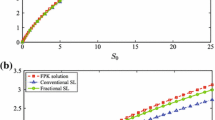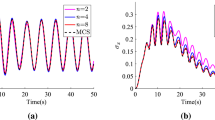Abstract
Many physical processes in nature exhibit complex dynamics that result from a combination of multiscale, nonlinear, non-local, and memory effects. Recent experimental measurements conducted in a variety of physical domains have shown that, at the macroscale level, these effects typically result in significant deviations from the behavior predicted by classical models. Notably, the underlying dynamics was often shown to be of non-integer order and possibly better captured by fractional-order models. Fractional operators are intrinsically multiscale; thus, they provide a natural approach to account for non-local and memory effects. In this study, we present the possible application of variable-order (VO) and distributed-order (DO) fractional operators to a few classes of nonlinear lumped parameter models that have great practical relevance in mechanics and dynamics. More specifically, we present a methodology to define VO and DO fractional operators that are capable of capturing various physical transitions characteristic of contact dynamics, nonlinear reversible systems, hysteretic systems, and nonlinear damped oscillator systems. Despite using simplified lumped parameters models to illustrate the application of VO and DO operators to mechanics, we show numerical evidence of their unique modeling capabilities as well as their connection to more complex systems at the continuum scale. Further, for a selected problem involving distributed nonlinear damping, we provide approximate analytical solutions that are helpful to better understand the underlying dynamics and to quantify the accuracy of our numerical models.







Similar content being viewed by others
References
Bagley, Ronald L., Torvik, P.J.: A theoretical basis for the application of fractional calculus to viscoelasticity. J. Rheol. 27(3), 201–210 (1983)
Chatterjee, Anindya: Statistical origins of fractional derivatives in viscoelasticity. J. Sound Vib. 284(3–5), 1239–1245 (2005)
Hollkamp, John P., Sen, Mihir, Semperlotti, Fabio: Model-order reduction of lumped parameter systems via fractional calculus. J. Sound Vib. 419, 526–543 (2018)
Hollkamp, John P., Semperlotti, Fabio: Application of fractional order operators to the simulation of ducts with acoustic black hole terminations. J. Sound Vib. 465, 115035 (2020)
Podlubny, Igor: Fractional Differential Equations: An Introduction to Fractional Derivatives, Fractional Differential Equations, to Methods of Their Solution and Some of Their Applications, vol. 198. Elsevier, Amsterdam (1998)
Glöckle, Walter G., Nonnenmacher, Theo F.: A fractional calculus approach to self-similar protein dynamics. Biophys. J. 68(1), 46–53 (1995)
Klass, Donald L., Martinek, Thomas W.: Electroviscous fluids. i. rheological properties. J. Appl. Phys. 38(1), 67–74 (1967)
Davis, L.C.: Model of magnetorheological elastomers. J. Appl. Phys. 85(6), 3348–3351 (1999)
Samko, Stefan G., Ross, Bertram: Integration and differentiation to a variable fractional order. Integral Trans. Spec. Functions 1(4), 277–300 (1993)
Caputo, Michele: Mean fractional-order-derivatives differential equations and filters. Annali dell’Universita di Ferrara 41(1), 73–84 (1995)
Lorenzo, Carl F., Hartley, Tom T.: Variable order and distributed order fractional operators. Nonlinear Dyn. 29(1–4), 57–98 (2002)
Coimbra, Carlos F.M.: Mechanics with variable-order differential operators. Annalen der Physik 12(11–12), 692–703 (2003)
Atanacković, Teodor M., Oparnica, Ljubica, Pilipović, Stevan: On a nonlinear distributed order fractional differential equation. J. Math. Anal. Appl. 328(1), 590–608 (2007)
Diaz, G., Coimbra, C.F.M.: Nonlinear dynamics and control of a variable order oscillator with application to the Van der Pol equation. Nonlinear Dyn. 56(1–2), 145–157 (2009)
Morales-Delgado, V.F., Gomez-Aguilar, J.F., Taneco-Hernandez, M.A., Escobar-Jimenez, R.F.: A novel fractional derivative with variable-and constant-order applied to a mass-spring-damper system. Eur. Phys. J. Plus 133(2), 78 (2018)
Coronel-Escamilla, A., Gómez-Aguilar, J.F., Torres, L., Escobar-Jiménez, R.F., Valtierra-Rodríguez, M.: Synchronization of chaotic systems involving fractional operators of Liouville–Caputo type with variable-order. Phys. A Stat. Mech. Appl. 487, 1–21 (2017)
Coronel-Escamilla, Antonio, Gómez-Aguilar, José Francisco, Torres, L., Valtierra-Rodriguez, Martin, Escobar-Jiménez, Ricardo Fabricio: Design of a state observer to approximate signals by using the concept of fractional variable-order derivative. Digital Signal Process. 69, 127–139 (2017)
Avalos-Ruiz, L.F., Zúñiga-Aguilar, C.J., Gómez-Aguilar, J.F., Escobar-Jiménez, R.F., Romero-Ugalde, H.M.: FPGA implementation and control of chaotic systems involving the variable-order fractional operator with Mittag-Leffler law. Chaos Solitons Fractals 115, 177–189 (2018)
Sweilam, N.H., Nagy, A., Assiri, T., Ali, N.Y.: Numerical simulations for variable-order fractional nonlinear delay differential equations. J. Fract. Calc. Appl. 6(1), 71–82 (2015)
Parsa Moghaddam, B., Yaghoobi, Sh, Tenreiro Machado, J.A.: An extended predictor–corrector algorithm for variable-order fractional delay differential equations. J. Comput. Nonlinear Dyn. 11(6), 061001 (2016)
Hartley, Tom T., Lorenzo, Carl F.: Fractional-order system identification based on continuous order-distributions. Signal Process. 83(11), 2287–2300 (2003)
Zhuang, J., Chen, Y., Podlubny, I.: Distributed-Order Dynamic Systems: Stability, Simulation, Applications and Perspectives, vol. 13. 01 (2012)
Wahi, Pankaj, Chatterjee, Anindya: Averaging oscillations with small fractional damping and delayed terms. Nonlinear Dyn. 38(1–4), 3–22 (2004)
Shen, Yongjun, Yang, Shaopu, Xing, Haijun, Gao, Guosheng: Primary resonance of Duffing oscillator with fractional-order derivative. Commun. Nonlinear Sci. Numer. Simul. 17(7), 3092–3100 (2012)
Lorenzo, C.F., Hartley, T.T.: Initialization, conceptualization, and application in the generalized (fractional) calculus. Crit. \(\text{Rev.}^{{\rm TM}}\) Biomed. Eng. 35(6), 447--553(2007)
Wilson, James F., Callis, Eric G.: The dynamics of loosely jointed structures. Int. J. Non-Linear Mech. 39(3), 503–514 (2004)
Chunduru, Seshu P., Kim, Meung J., Mirman, Cliff: Failure analysis of railroad couplers of AAR type E. Eng. Fail. Anal. 18(1), 374–385 (2011)
Chondros, T.G., Dimarogonas, Andrew D., Yao, J.: Vibration of a beam with a breathing crack. J. Sound Vib. 239(1), 57–67 (2001)
Semperlotti, F., Wang, K.W., Smith, E.C.: Localization of a breathing crack using super-harmonic signals due to system nonlinearity. AIAA J. 47(9), 2076–86 (2009)
Kim, Gi-Woo, Johnson, David R., Semperlotti, F., Wang, K.W.: Localization of breathing cracks using combination tone nonlinear response. Smart Mater. Struct. 20(5), 055014 (2011)
Lamberti, Alfredo, Semperlotti, Fabio: Detecting closing delaminations in laminated composite plates using nonlinear structural intensity and time reversal mirrors. Smart Mater. Struct. 22(12), 125006 (2013)
Hopkinson, Bertram, Williams, Trevor G.: The elastic hysteresis of steel. Proc. R. Soc. Lond. Ser. A Contain. Papers Math. Phys. Character 87(598), 502–511 (1912)
Zhang, J., Lin, Z., Wong, Aea, Kikuchi, N., Li, V.C., Yee, A.F., Nusholtz, G.S.: Constitutive modeling and material characterization of polymeric foams. J. Eng. Mater. Technol. 119(3), 284–291 (1997)
Srinivas, K., Lakshmana Rao, C., Parameswaran, Venkitanarayanan: Experimental investigation of rate sensitive mechanical response of pure polyurea. In: Dynamic Behavior of Materials, Vol. 1, pp. 173–179. Springer, (2019)
Baber, Thomas T., Noori, Mohammed N.: Modeling general hysteresis behavior and random vibration application. J. Vib. Acoust. Stress Reliab. Des. 108(4), 411–420 (1986)
Bhattacharjee, Arindam, Chatterjee, Anindya: Dissipation in the Bouc-Wen model: small amplitude, large amplitude and two-frequency forcing. J. Sound Vib. 332(7), 1807–1819 (2013)
Moon, Francis C., Kalmár-Nagy, Tamás: Nonlinear models for complex dynamics in cutting materials. Philos. Trans. R. Soc. Lond.Ser. A Math. Phys. Eng. Sci. 359(1781), 695–711 (2001)
Onoda, Junjiro, Minesugi, Kenji: Semiactive vibration suppression by variable-damping members. AIAA J. 34(2), 355–361 (1996)
Symans, M.D., Constantinou, M.C.: Passive fluid viscous damping systems for seismic energy dissipation. ISET J. Earthq. Technol. 35(4), 185–206 (1998)
Maiti, Soumyabrata, Bandyopadhyay, Ritwik, Chatterjee, Anindya: Vibrations of an Euler-Bernoulli beam with hysteretic damping arising from dispersed frictional microcracks. J. Sound Vib. 412, 287–308 (2018)
Li, Changpin, Zeng, Fanhai: Numerical Methods for Fractional Calculus. Chapman and Hall/CRC, London (2015)
Sanders, J.A., Verhulst, F.: Averaging Methods in Nonlinear Dynamical Systems. Springer, Berlin (1985)
Nayfeh, Ali H., Mook, Dean T.: Nonlinear Oscillations. Wiley, Hoboken (2008)
Meerschaert, Mark M., Nane, Erkan, Vellaisamy, P.: Distributed-order fractional diffusions on bounded domains. J. Math. Anal. Appl. 379(1), 216–228 (2011)
Crisfield, M.A.: An arc-length method including line searches and accelerations. Int. J. Numer. Methods Eng. 19(9), 1269–1289 (1983)
Wahi, Pankaj, Chatterjee, Anindya: Self-interrupted regenerative metal cutting in turning. Int. J. Non-Linear Mech. 43(2), 111–123 (2008)
Acknowledgements
The authors gratefully acknowledge the financial support of the National Science Foundation (NSF) under the grant #1825837, and the Defense Advanced Research Project Agency (DARPA) under grant #D19AP00052.
Author information
Authors and Affiliations
Corresponding author
Ethics declarations
Conflicts of interest
F.S. is the founder of M3SIM LLC, and the research results may potentially benefit the business scope and activities of the company. The terms of this arrangement have been reviewed and approved by the Purdue University in accordance with its conflict of interest policies.
Additional information
Publisher's Note
Springer Nature remains neutral with regard to jurisdictional claims in published maps and institutional affiliations.
Appendix
Appendix
Consider the averaging integral given in Eq. (30):
Using the coordinate transformation \(\tau =t-s\), and trigonometric relations for double angles, we obtain:
The right-hand side of the above equation consists of two integrals which we denote as \(I_1\) (containing \(\cos (\cdot )\) terms) and \(I_2\) (containing \(\sin (\cdot )\) terms). Note that \(\alpha (x)\) is an implicit function of time such that \(\alpha (x)=\alpha (x(t))\). We first evaluate \(I_1\) by using integration by parts in the following manner:
We use Leibniz’s rule to perform the differentiation in the second integral of \(I_1\). Further, under the limiting condition \(T\rightarrow \infty \), the above integral simplifies to the following:
where
In the above equation, \(\psi (x)\) is the digamma function and is defined as the logarithmic derivative of the gamma function, i.e., \(\psi (x)=\varGamma '(x)/\varGamma (x)\). Now consider the following part of the integration in Eq. (51) denoted as \(I_3\):
For \(\alpha (x)\in (0,1)\) and a smooth variation of \(\alpha (x)\) (as already assumed in Sect. 5), it can be shown that g(x, t) is bounded. Note that g(x, t) is an implicit function of time. Assuming \(M=\sup |g(x,t)|~\forall ~t\in (0,T)\) and using the slow flow \(\dot{x}\) from Eq. (25), we obtain the inequality:
which under the slow flow constraint simplifies to:
Thus, \(|I_3|\rightarrow 0\) as \(\lim \limits _{T\rightarrow \infty }x(T)\rightarrow 0\). This simplifies Eq. (51) to:
Applying integration by parts to the second integral above and by repeating the arguments used to obtain the Eqs. (53–55), it can be shown that the second integral similarly simplifies to zero. Now, using the standard integration result:
we obtain:
where \(\alpha _{\infty }=\lim \limits _{T\rightarrow \infty }\alpha (x(T))\). Similarly, it can be shown that the integral \(I_2\) in Eq. (49) simplifies to zero. Now collecting all the above terms the integral I in Eq. (48) is obtained as:
The above integration procedure becomes fairly straightforward when the order \(\alpha \) of the Caputo operator is a constant and can be found in [23, 24].
Rights and permissions
About this article
Cite this article
Patnaik, S., Semperlotti, F. Application of variable- and distributed-order fractional operators to the dynamic analysis of nonlinear oscillators. Nonlinear Dyn 100, 561–580 (2020). https://doi.org/10.1007/s11071-020-05488-8
Received:
Accepted:
Published:
Issue Date:
DOI: https://doi.org/10.1007/s11071-020-05488-8




